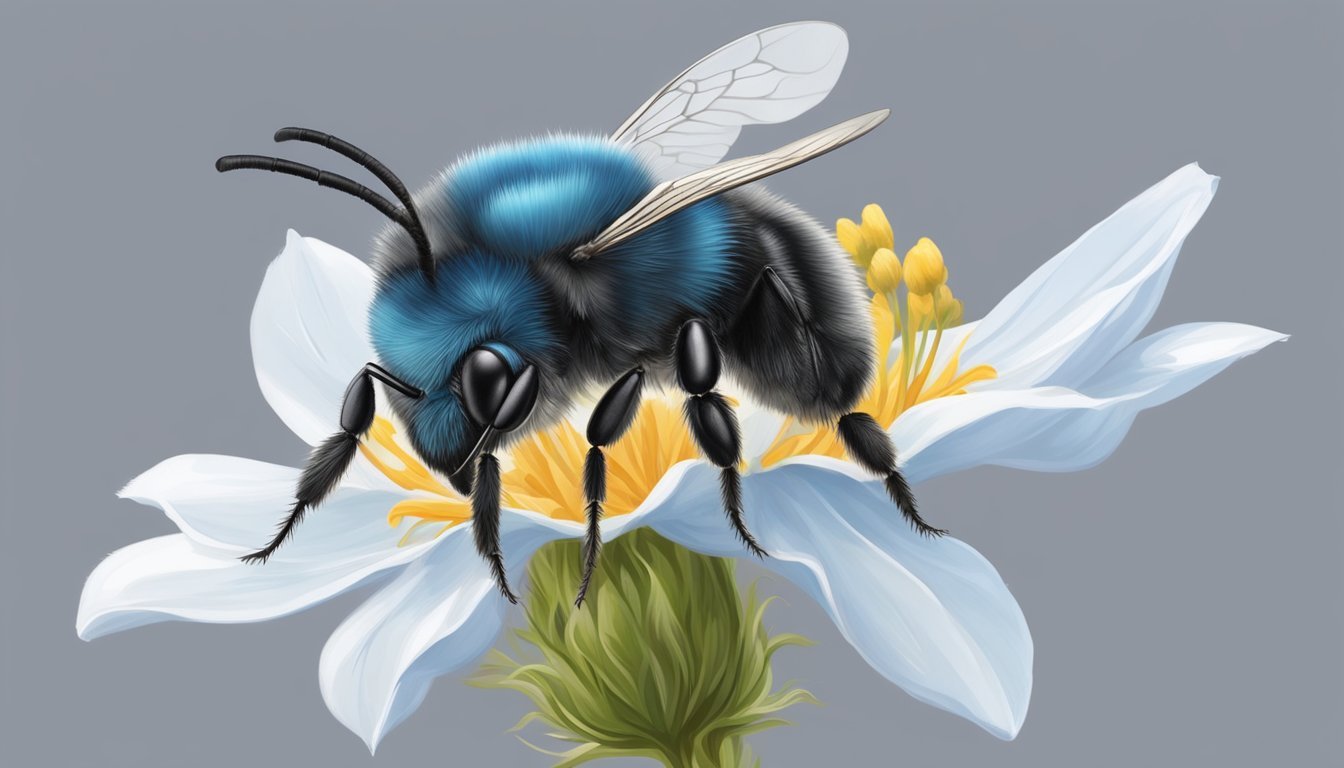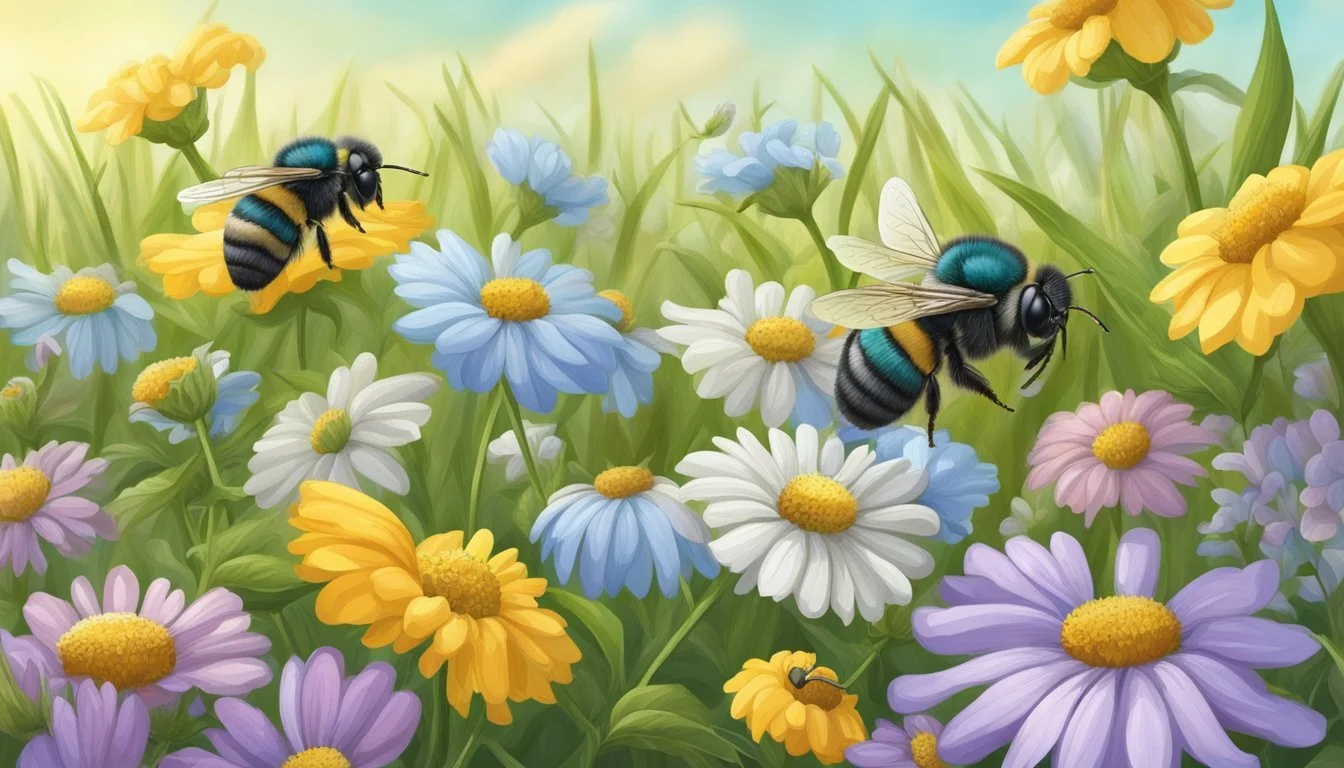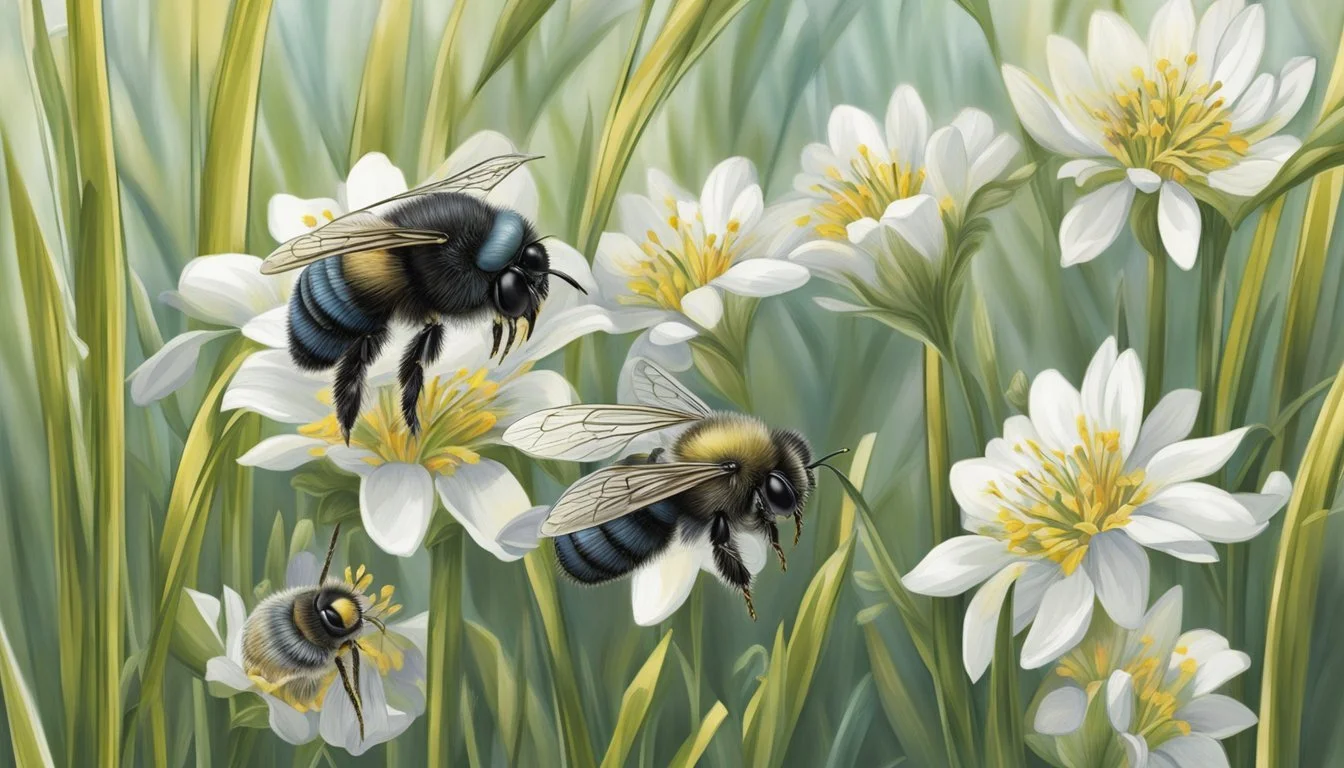Mason Bees
Essential Pollinators in Your Garden
Mason bees, a group of bee species from the genus Osmia, are vital yet often overlooked effective pollinators in many ecosystems. Unlike the more renowned honey bees, mason bees are solitary creatures and do not form large colonies. These bees earn their name from their unique nesting habits, which involve using mud and other materials to construct their nesting chamber in existing small cavities, often in stone or wood cavities that were left by wood-boring beetles. Their ability to carry pollen efficiently makes them excellent pollinators, particularly in the early spring when they emerge and flowering plants are in need of their services.
For personal garden ecosystems in North America, native pollinators play a crucial role in the pollination of flowers, fruits, and vegetables during spring time. Since they forage for pollen to feed their offspring, they inadvertently transfer pollen from bloom to bloom of spring flowers, t1hereby fertilizing plants and contributing to a healthy and thriving garden. These bees are non-aggressive and less likely to sting than other bee species, making them ideal for gardeners looking to enhance pollination without the concerns associated with managing more temperamental species.
Understanding the habitat and lifecycle of mason bees is essential for anyone interested in promoting pollinator-friendly environments. Providing suitable housing, such as bee boxes or nesting tubes, can encourage these industrious insects to take up residence in a garden. Recognizing their importance, gardeners and farmers are increasingly creating spaces that support the conservation of mason bees, which in turn, ensures the productivity and biodiversity of the garden and larger agricultural landscapes.
Biology and Characteristics of Mason Bees
Mason bees are fascinating native pollinators, known for their unique nesting habits and solitary lifestyle, which stand in contrast to the social structures of honeybees and bumblebees. Their efficient pollination of plants is vital for ecosystems and agriculture.
Species and Habitat
There are over 300 species of mason bees in the genus Osmia, with a wide variety of habitats. They are prevalent in the Northern Hemisphere, particularly in temperate climates. Mason bees often use mud to construct their nests in pre-existing nearby nesting cavities, such as holes in wood left by wood-boring insects or in hollow stems of plants. Some species, like the Osmia bicornis, are native to North America and can frequently be found buzzing around gardens and woodlands.
Physical Traits and Behavior
Physically, mason bees can be identified by their metallic sheen, with colors ranging from blue to green and even black. Males are typically smaller than females, with longer antennae and a tuft of light-colored hairs on the head. Unlike honeybees, mason bees don't have barbed stingers, making them less likely to sting. As solitary bees, they do not form colonies; instead, each female mason bee operates independently, collecting pollen and nectar with the use of their front and hind legs for the provisioning of their nests.
Reproduction and Life Cycle
The life cycle of mason bees begins with the emergence of adults in early spring. Females lay eggs in the nesting chamber that they create, with each egg housed in its own chamber, separated by mud partitions. After laying an egg, the chamber is filled with pollen and nectar as food for the future larva. The egg then develops into a larva, which spins a cocoon and overwinters, emerging as an adult bee the following spring. Male mason bees typically have a shorter lifespan, often dying shortly after mating.
Mason Bees in Pollination and Agriculture
Mason bees are highly valued for their pollination services, particularly in agricultural settings such as orchards. These bees play a critical role in ecosystem health and enhance the yield and quality of crops.
Role in Ecosystem and Pollination
Mason bees, with their remarkable foraging abilities, serve as fantastic pollinators within ecosystems. They collect pollen and nectar from a variety of plants, which is not only used for their own sustenance but also results in the transfer of pollen from one flower to another. This process of pollination is vital for plant reproduction and biodiversity.
Benefits to Crops and Orchards
In the context of agriculture, the orchard mason bee is especially efficient in the pollination of berry crops, fruit trees, and a wide variety of flowering produce. On farms and in orchards, the presence of these docile pollinators can lead to better fruit set and larger harvests. Evidence suggests that their pollination not only enhances the quantity of produced fruits but also contributes to improving their quality.
Comparison With Honey Bees
While honey bees are the most commonly known pollinators, mason bees offer certain advantages. They tend to start their activity earlier in the day and in cooler temperatures, which complements the pollination process. Moreover, orchard mason bees are solitary and do not produce honey but are efficient pollinators of a wide range of crops, making them a valuable asset in agriculture.
Raising and Caring for Mason Bees
Raising mason bees involves providing safe habitats and vigilant protection against pests and diseases. These extraordinary pollinators require specific conditions for thriving that can be met through effective bee house design and maintenance strategies.
Creating Habitats and Bee Houses
Creating a suitable habitat for mason bees is crucial for their lifecycle and overall health. When designing mason bee houses, it's important to use natural and untreated materials such as wood or bamboo, which are safe for the bees and mimic their natural nesting preferences.
The dimensions of the nesting holes are also critical; they should be 5/16-inch in diameter to accommodate the bees comfortably and should be at least 3-6 inches deep to provide sufficient space for laying eggs and storing pollen. To optimize the conditions for the bees, the houses should be oriented to face east or southeast, which allows them to receive the warming morning sunlight.
Additionally, the habitat should be protected from harsh conditions; it should be placed in a location sheltered from wind, rain, and the intense midday sun to maintain the right moisture levels and ensure a hospitable environment for the bees.
When situating habitats for bees, it is essential to place them in close proximity to flowering plants, which supply the bees with an abundant source of pollen and nectar necessary for their nourishment. To protect the bees from predators, habitats should be positioned at least 3 feet above the ground.
It's important to locate these habitats away from areas with heavy foot or vehicle traffic to minimize disturbances that could stress or harm the bees. By considering these factors, you can create a safe and resource-rich environment for bees to thrive.
Protection from Pests and Diseases
Mason bees, like many other species, face threats from pests such as Varroa mites and various parasites that can jeopardize their health and productivity. To combat these issues, it's important to regularly check and clean bee houses to control potential infestations. Remember that fungal diseases are a concern, particularly in moist environments, so bee houses should be well-ventilated to prevent excessive dampness that can encourage these diseases.
To protect mason bees effectively, certain measures should be taken. Cleaning out the nesting tubes at the end of the season is crucial to eliminate any remaining pests or disease spores. Implementing physical barriers, like mesh screens, can also help to keep larger pests from entering the bee houses. This is why diligent monitoring of bee activity and health is vital, with prompt removal of any nesting materials that appear to be compromised, ensuring that the bee population remains robust and healthy.
By following these specific guidelines, one can raise mason bees successfully, supporting the overall ecosystem through their proficient pollination.
Conservation and Environmental Impact
Mason bees play a critical role in the ecosystem as vital pollinators. Their conservation is deeply intertwined with environmental health, affecting native flora and agricultural diversity.
Challenges and Threats to Mason Bees
Mason bees have got a bit of a situation on their hands—or wings, I should say. They're in a bit of a bind with their homes disappearing faster than a plate of cookies at a kids' party. Urban sprawl and farms expanding are eating up the native habitats these bees love and need. They're all about those specific vibes that native flowers give off, which sadly tend to vanish when their environments are trashed.
Now, let's talk pesticides. They're like the uninvited guests that crash the party and eat all the food. Mason bees get hit hard by these chemicals, which can straight-up poison them or take out the plants they need to survive. Either way, it's a lose-lose for our buzzy friends.
Disease is another party pooper in the bee world. Illnesses can spread like wildfire, whether from their own crew or outsiders, and that's bad news for bee health and numbers.
And climate change? Well, it's throwing everyone for a loop, bees included. It's messing with the timing of flower blooms, and when the bees show up ready to chow down, they might find the kitchen closed. It's like showing up to a concert only to find out it was last week.
Lastly, many mason bees aren't the adventurous type. They stick to their local haunts and don't reproduce like rabbits, so their populations are pretty vulnerable. With a small stomping ground and a slow birth rate, bouncing back from any of these issues is like trying to climb a mountain in flip-flops. It's a tough gig, but hey, these little guys are survivors.
Promoting Mason Bee Populations
Alright, let's dive into the world of mason bee conservation—it's like a backyard revolution with a cause. Protecting what's left of the natural digs these bees call home is super important. Restoring native plant hangouts not only cranks up the biodiversity volume but also gives these little pollinators the VIP treatment with top-notch forage and primo nesting spots.
Now, knowledge is power, right? So, teaching folks about mason bees is key. It's all about turning regular Joes and Janes into backyard conservation heroes. The more people know, the more they can do to help out, like setting up bee hotels and planting bee-friendly flowers.
And here's a biggie: saying "no thanks" to pesticides. If we can nudge people to use bee-safe alternatives, especially where these bees are buzzing around, we can give them a fighting chance at a healthier life.
But hey, we can't do it alone. Throwing some dollars and support behind the science whizzes means they can cook up even smarter ways to keep these bees in the game.
By tackling these challenges head-on and giving mason bees a leg up, we're not just helping our little winged buddies; we're keeping the circle of life spinning. These bees are like the unsung heroes of the environment, making sure all those wild plants and yummy crops get their pollination groove on.
Keep the Buzz Going
It's clear that mason bees are unsung champions of the pollination world. They may not produce honey or dance in swarms, but their solitary work ethic and efficient pollination skills are invaluable to our ecosystems and food supply. As gardeners, farmers, and nature enthusiasts, we have the opportunity—and responsibility—to support these hardworking insects.
The call to action is simple yet powerful: create and maintain bee-friendly habitats, educate ourselves and our communities, and make conscious choices that benefit, rather than harm, our buzzing buddies. By doing so, we're not only ensuring the survival of mason bees but also protecting the intricate web of life that sustains us all.
So let's take a moment to appreciate these industrious creatures and do our part to safeguard their future. Whether it's setting up a bee house, planting a pollinator garden, or supporting research and conservation efforts, every action counts. Together, we can ensure that mason bees continue to thrive and, in turn, keep our environment buzzing with life. Here's to the mighty mason bee, the tiny powerhouse that holds a world of impact in its wings.






